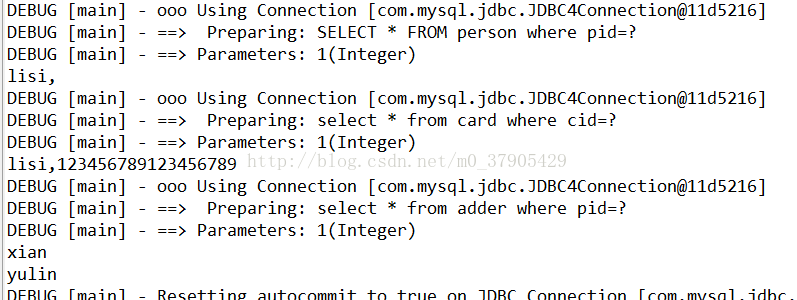lazy策略原理:只有在使用查詢sql返回的數(shù)據(jù)是才真正發(fā)出sql語句到數(shù)據(jù)庫,否則不發(fā)出(主要用在多表的聯(lián)合查詢)
1.一對一延遲加載:
假設(shè)數(shù)據(jù)庫中有person表和card表:其中person表中有字段pid,pname,page,psex,cid,card表中有字段cid,cnum;
假設(shè)要查詢某個人的姓名和身份證號碼:
原理:在查詢姓名時,實際本沒有查詢出身份證號碼的信息,只有當(dāng)前臺使用身份證號時才發(fā)出對card的查詢,需要查詢出身份證號碼是采取查詢的一種策略;
實現(xiàn)實例:
實現(xiàn)步驟:
1-導(dǎo)入mybatis 的依賴jar包
2-添加log4j文件 (可查看內(nèi)存中實際執(zhí)行的程序)
1-原理:只有當(dāng)前臺使用身份證號時才發(fā)出對card的查詢,否則只發(fā)出person信息的查詢
2-開啟lazy:在conf.xml
|
1
2
3
4
|
<settings> <setting name="lazyloadingenabled" value="true"/> <setting name="aggressivelazyloading" value="false"/> </settings> |
3.實現(xiàn):
(1)在mapper.xml映射文件中:
|
1
2
3
4
5
6
7
8
9
10
11
12
13
14
15
16
|
<select id="findcid" parametertype="int" resulttype="card"> select * from card where cid=#{value} </select> <resultmap type="person" id="p_c1"> <id column="pid" property="pid" /> <result column="pname" property="pname" /> <result column="page" property="page" /> <result column="psex" property="psex" /> <association property="card" javatype="card" select="findcid" column="cid"> </association> </resultmap> <select id="selectpersonandcardlazybypid" parametertype="int" resultmap="p_c1"> select * from person where pid=#{value} </select> |
1-select:指定關(guān)聯(lián)的查詢語句
2-column:指定主語句中的哪個字段的值作為參數(shù)傳遞給從sql語句
(2)在mapper接口中定義方法:
|
1
|
public person selectpersonandcardlazybypid(int pid); |
(3)使用junit測試結(jié)果:
1.此處是只發(fā)出person信息的查詢;
|
1
2
3
4
5
6
7
|
@test public void testselectpersonandcardlazybypid(){//lazy策略一對1 person p=pm.selectpersonandcardlazybypid(1); //system.out.println(p); system.out.println(p.getpname()+","); //system.out.println(p.getpname()+","+p.getcard().getcnum()); } |
結(jié)果執(zhí)行的查詢語句:

2.當(dāng)前臺使用身份證號時才發(fā)出對card的查詢
|
1
2
3
4
5
6
7
|
@test public void testselectpersonandcardlazybypid(){//lazy策略一對1 person p=pm.selectpersonandcardlazybypid(1); //system.out.println(p); system.out.println(p.getpname()+","); system.out.println(p.getpname()+","+p.getcard().getcnum());//當(dāng)前臺使用身份證號時才發(fā)出對card的查詢 } |
結(jié)果執(zhí)行的查詢語句:

2.一對多延遲加載:
實現(xiàn)實例:
假設(shè)數(shù)據(jù)庫中有person表和card身份信息表,adder地址表:其中person表中有字段pid,pname,page,psex,cid,card表中有字段cid,cnum;adder表有字段aid,ashi,pid
假設(shè)要查詢某個人的姓名和住址,身份證號碼:
(1)mapper.xml映射文件:
|
1
2
3
4
5
6
7
8
9
10
11
12
13
14
15
16
17
18
19
20
21
22
23
|
<!-- lazy策略一對多 --> <select id="fingcard_adder" parametertype="int" resulttype="adder"> select * from adder where pid=#{value} </select> <select id="findcid1" parametertype="int" resulttype="card"> select * from card where cid=#{value} </select> <resultmap type="person" id="p_c1_a1"> <id column="pid" property="pid" /> <result column="pname" property="pname" /> <result column="page" property="page" /> <result column="psex" property="psex" /> <association property="card" javatype="card" select="findcid1" column="cid"> </association> <collection property="adder" oftype="adder" select="fingcard_adder" column="pid"> </collection> </resultmap> <select id="selectpersonandcardandadderlazybypid" parametertype="int" resultmap="p_c1_a1"> select * from person where pid=#{value} </select> |
(2)mapper接口定義方法:
1.此處是只發(fā)出person信息的查詢;
|
1
2
3
4
5
|
@testpublic void testselectpersonandcardandadderlazybypid(){//lazy策略一對多 person p=pm.selectpersonandcardandadderlazybypid(1); system.out.println(p.getpname()+",");////此處是只發(fā)出person信息的查詢 } |
結(jié)果執(zhí)行的查詢語句:

2.此處是發(fā)出person信息和身份信息的查詢;
|
1
2
3
4
5
6
|
@testpublic void testselectpersonandcardandadderlazybypid(){//lazy策略一對多 person p=pm.selectpersonandcardandadderlazybypid(1); system.out.println(p.getpname()+",");//此處是只發(fā)出person信息的查詢; system.out.println(p.getpname()+","+p.getcard().getcnum());//此處是發(fā)出person信息和身份信息的查詢; } |
結(jié)果執(zhí)行的查詢語句:

3.此處發(fā)出person信息和身份信息,地址信息的查詢;
|
1
2
3
4
5
6
7
8
9
10
|
@testpublic void testselectpersonandcardandadderlazybypid(){//lazy策略一對多 person p=pm.selectpersonandcardandadderlazybypid(1); system.out.println(p.getpname()+",");//此處是只發(fā)出person信息的查詢; system.out.println(p.getpname()+","+p.getcard().getcnum());//此處是發(fā)出person信息和身份信息的查詢; //system.out.println(p.getpname()+","+p.getcard().getcnum()); for (adder adder : p.getadder()) {////此處發(fā)出person信息和身份信息,地址信息的查詢; system.out.println(adder.getashi()); } } |
結(jié)果執(zhí)行的查詢語句:

總結(jié)
以上所述是小編給大家介紹的mybatis中延遲加載lazy策略的方法,希望對大家有所幫助,如果大家有任何疑問歡迎給我留言,小編會及時回復(fù)大家的!
原文鏈接:https://blog.csdn.net/m0_37905429/article/details/77074312














